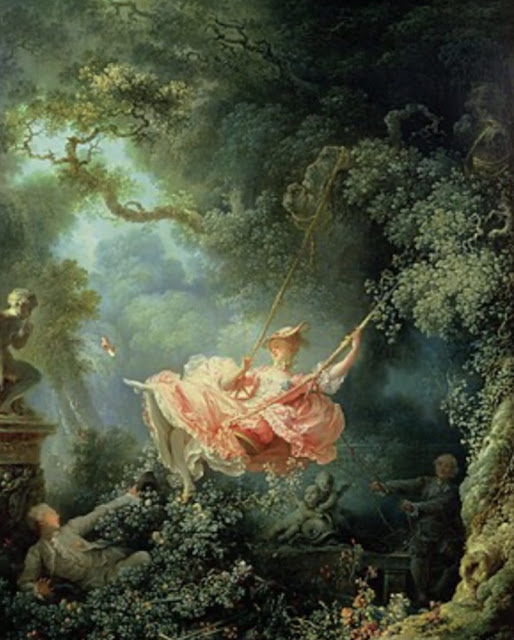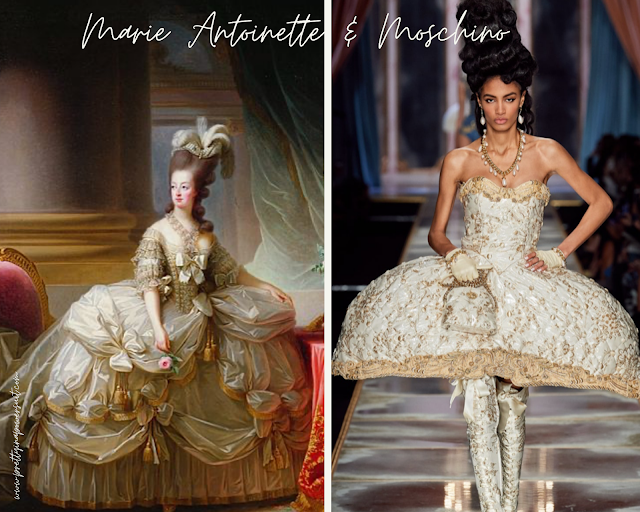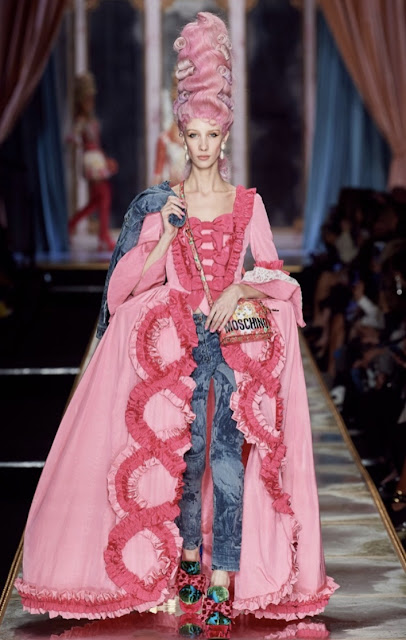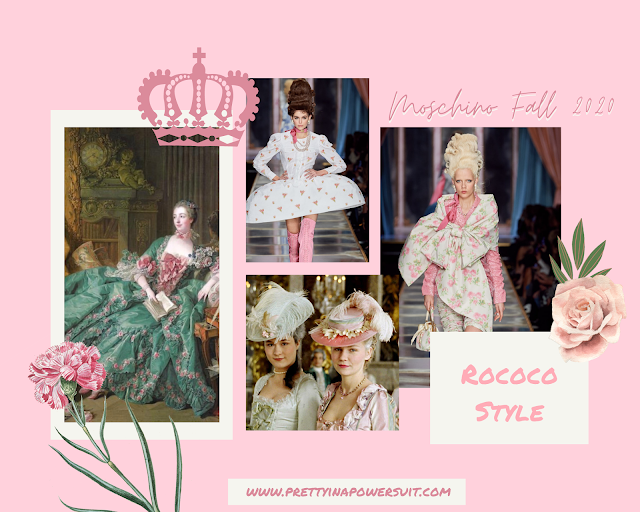Cake and couture...the perfectly sweet combination that epitomizes the era of Marie Antoinette. She ruled the late-1700s fashion scene as the Dauphine and later Queen of France from 1774-1793. Her years in the French palace were forever marked by her style choices.
Madame de Pompadour by Francois Boucher, 1759
Before Marie Antoinette arrived to the palace and made her mark on French fashion, Madame de Pompadour embodied the beauty of Rococo style. She became famous as the mistress to King Louis XV. She epitomized the look of the era with luxurious gowns that included soft pastel hues, decorative details and romantic designs.
Mid and late 18th century fashion for women during the Rococo period included plenty of ribbons, lace and ruffles on heavy silk brocades, gowns fitted with corsets and silhouettes widened by panniers. The goal of a woman’s gown was always one of elegance, extravagance and beauty.
Candy colors, florals and romance abound with Moschino designs perfect for Marie Antoinette or a Rococo painting. Pictured in collage: Declaration of Love by Jean Francois de Troy 1731, Kirsten Dunst as Marie Antoinette & Rococo worthy Moschino designs
Gowns designed in such a manner went along with the playful, flirty and romantic notions often associated with the period. And with the young Marie Antoinette parading through the halls of Versailles, candy colored gowns with plenty of frivolity were the perfect look.
Gold decadence as worn by Marie Antoinette and Moschino. Painting: Marie Antoinette in Court Dress by Elisabeth Vigee-Lebrun, 1778
Power dressing is not a new concept, nor is it confined to the boardrooms of corporations. Even in the 1700s, women like Marie Antoinette were able to use fashion to communicate their position, ideas and power. At that time, women did not have the liberties of holding a job, voting or owning property. With the limitations of the time period, clothing became a primary means of communication. Wealthy women like Marie Antoinette and courtiers in the palace had greater opportunities to indulge in expensive fabrics, designs and accessories as a part of their fashion expression.
Modern day panniers are seen in this pink dress where the dress extends outward at the hips.
Designs that included the hip widening panniers are the perfect example of fashion putting class, femininity and position on display. This type of fashion allowed a woman to communicate her higher class status, since she obviously could not work while wearing such a design. It also called attention to the femininity of her silhouette as her hips sashayed through the ballroom. Plus, it had the added benefit of highlighting the woman wearing such a dress. Others couldn’t help but notice the woman walking sideways to fit through the doorway or having a circle of admirers around her wide gown. Even without a voice in politics or commerce, a woman could use her fashion choices to claim her space and make an impression on those around her.
Rococo style includes pastels, florals and romantic detailing. Pictured in collage: Madame Pompadour by Francois Boucher 1756, Kirsten Dunst as Marie Antoinette & Rococo worthy Moschino designs
As is his trademark, designer Jeremy Scott embraced such extravagant beauty in his Fall 2020 show for Moschino. The Rococo era collided with elements from the 1980s in the perfect combination of decadence worthy of a modern Marie Antoinette. Denim, leather and heavy metal jewelry befitting a Dynasty-era diva were used alongside Rococo ribbons, hip-widening panniers and sky-high hair.
As is his trademark, designer Jeremy Scott embraced such extravagant beauty in his Fall 2020 show for Moschino. The Rococo era collided with elements from the 1980s in the perfect combination of decadence worthy of a modern Marie Antoinette. Denim, leather and heavy metal jewelry befitting a Dynasty-era diva were used alongside Rococo ribbons, hip-widening panniers and sky-high hair.
The Moschino pant suits with plenty of feminine flair were reminiscent of Rococo menswear with luxurious fabrics, embroidery and lace. The cropped pants and fitted jacket on the Moschino runway were much like the breeches and waistcoat combo worn by fashionable Rococo-era men while at the royal court.
1980s style party dresses got a Rococo twist with pastel color palettes, ribbons, glittering jewels and towering hair styles. Decadence crossed time periods with the merging of Rococo and 1980s elements.
Marie Antoinette in a Muslin Dress by Elisabeth Vigge-Lebrun, 1783
Peace, love and panniers...this pink ensemble combines Rococo frivolity with 1980s decadence.
Runway Photos: Photographed by Filippo Fior for Moschino on Vogue.com
Paintings from the Public Domain via Wikimedia Commons



















